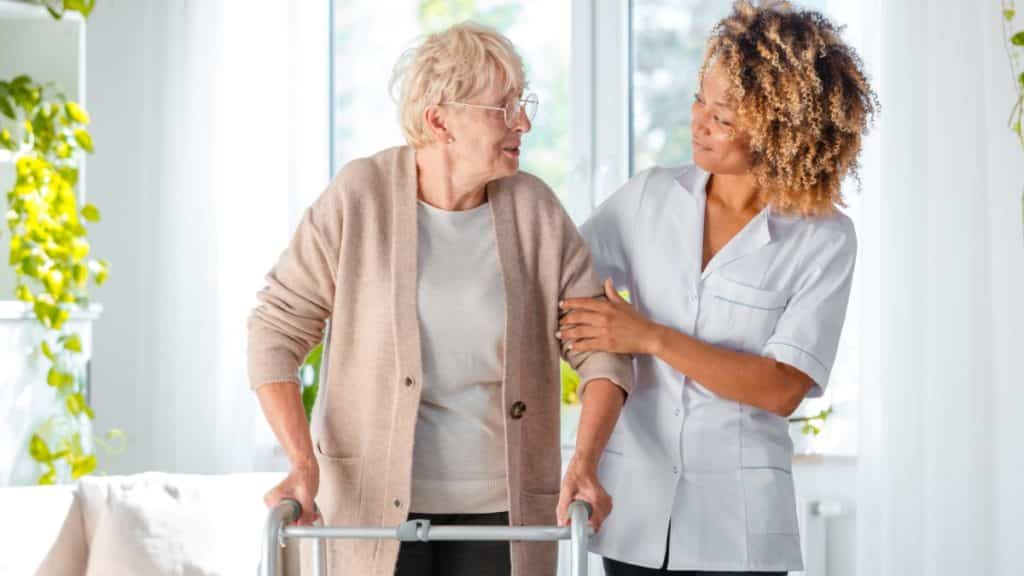A fall can be a life-altering health crisis for a senior, and this accident affects far too many. In fact, the CDC reports that 1 in 4 older adults fall each year. Three million of these seniors will need treatment for fall-related injuries.
Detecting a fall and getting help quickly is critical for improved health outcomes. Preventing the fall in the first place is even better. Until fairly recently, healthcare had few solutions beyond basic systems to call for help, physical therapy, and changes to the home. But this is changing.
Advances in technology, especially in the areas of affordable tech and AI, are expanding this safety net for seniors. A market that once had only a few basic fall-detection devices is now starting to fill with a wide range of scientifically backed options. Meanwhile, other tech still in the development phase holds exciting promise for a safer and healthier future for our senior population.
Fall Detection
Fall detection systems first hit the market with the famous life alert commercials in the late 80s. Devices like these used to be relatively simple. The wearable item had a button on it that a fallen senior could use to connect to emergency services. Many of today’s fall detection devices work under the same principles, although today’s pendants and watches often come with more functions.
Smart watches offer an even more sophisticated take on wearable fall detectors. These watches don’t rely on the senior being conscious and alert enough to hit an emergency button. Instead, they can proactively detect falls and reach out for help if the wearer is non-responsive.
Apple is leading the way in this space. Their Apple Watch SE and the Apple Watch Series 4 and Series 5 have fall detection functions. Samsung isn’t far behind, either. They’ve introduced a fall detection feature starting with the Galaxy Watch 3.
Along with fall detection, smart watches bundle together other health-promoting features like sleep monitoring and fitness trackers. These may indirectly help seniors stay mobile and active, as well as offering medical teams some valuable data points.
Finally, some seniors may prefer these advanced devices over visually obvious medical alert pendants. Samsung’s Galaxy Watch 3, in particular, has a very traditional look. A senior who resists wearing the traditional alert device may feel comfortable with a sleek watch.
Not all alert systems are wearable. Some devices can be installed strategically throughout the home. These have the advantage that they can be connected to a power supply, so caregivers don’t need to worry about keeping batteries charged.
Many of these installed alert devices offer push-button, emergency pull cord, and voice activation. Tech like the Walabot Home can also directly detect falls with the use of radar 3D imaging. All of these systems can reduce that critical time between a fall and receiving emergency care.
Fall Prevention
Preventing that fall in the first place is the ultimate goal. The limited technology of years past has meant that most interventions were focused on basic coaching and physical therapy. These basic interventions are still a valuable part of a broader fall prevention strategy, but they’re now being enhanced with higher-tech solutions. For example, as seniors have long been advised to light up areas like dark staircases to prevent falls, this can be supplemented with smart light bulbs and motion sensors, triggering the lights as soon as the senior enters the room.
Meanwhile, physical therapy has long been one of the gold standards to reduce falls by improving strength and balance. These therapies are now being supported by smart tech. Some therapists are integrating assisted balance and walking robots into their toolset. These devices don’t replace the assessment process; they enhance it. A combination of sensors and AI can help the therapist precisely identify muscle imbalances to target with exercises.
Certain companies are taking balance detection and assistance tech into the wearable market as well. There are a number of smart shoes, smart socks, and foot braces being developed for fall prevention. These have an array of sensors that can detect motion, cadence, gait and more. If they predict a coming fall, smart shoes and the like may be able to use built-in motors to help seniors regain their balance – offering not only fall prevention, but actual assisted rebalancing.
Physical therapists have also been enhancing their exercise programs with exergames and mixed reality technology. Studies have shown this tech creates a statistically significant improvement in balance and physical strength. Seniors may find it easier to stick with demanding and uncomfortable programs when they’re getting encouragement from the game. These tech-enhanced programs can also make take-home exercises more effective, as the patient gets continuous feedback on whether they’re doing the exercises correctly. This becomes more important as seniors increasingly opt to age in place in their own home
Advances in machine learning have also opened up a new and exciting avenue for fall prevention. Vuetech Health Innovations has been developing an Emergency Video Alert system. This system uses a combination of computer vision and machine learning to analyze live feeds from a room. The program can recognize warning signs of an impending fall or other event and send out an alert to caregivers. What about patient privacy? This tech analyzes and deletes the video feed almost instantly. In the near future, affordable AI-powered technology may even be able to prevent falls entirely.


